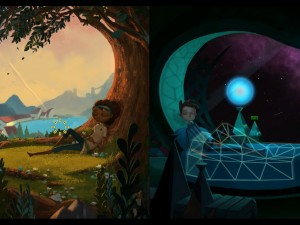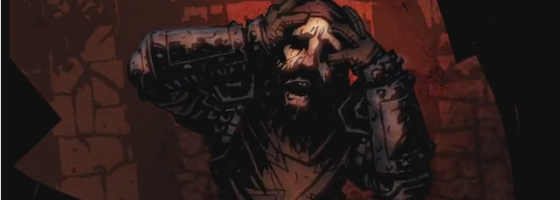Recently, former Bioware developers got together to pitch the Kickstarter for Mooncrest, a return of old school RPG design with modern combat. And while their pedigrees are impressive, they messed up with one of the most amateurish Kickstarter presentations I’ve seen this year. Kickstarter is no longer in the gold rush period set by games like Broken Age and Planetary Annihilation, and it’s important for would be Kickstarter project makers to understand what needs to be in a Kickstarter to avoid the same fate as Mooncrest.
The Video:
The original Kickstarter video for Mooncrest was … special to say the least and it has since been taken down, but someone did manage to save a copy of it on YouTube. Regarding examining that video and what’s wrong with it from a storytelling and presentation angle, while it would be a fun activity, is not the point of this topic. The big red flag is that there was no in-game or proof of concept explanation anywhere in that video.
And that takes us to point one: KICKSTARTERS NEED GAME FOOTAGE; either actual footage of the game in action or something to show off the proof of concept and basic game engine. The days of your video essentially saying, “I want to make something cool, so please give me money,” are over. Kickstarter backers are a lot more leery of Kickstarter video game projects and they are expecting more.

The days of a kickstarter succeeding without having any in game or concept footage are gone; backers are a lot more critical of projects now
I have to point out the amazing work that Redhook Games did with their Kickstarter video: They didn’t need to show themselves, ask for money, or make a cute little skit. Instead, we got two minutes showing off what kind of game they wanted to make while using in game graphics and aesthetics.
If you want your main video to be a skit or you talking about your game, you can do that, but there still needs to be something that shows your game off somewhere on the Kickstarter page, which takes us to the next point.
Describing the Game:
One of the challenges of funding a game through Kickstarter is the fact that you are pitching something that in most cases, you have no idea how it will turn out. Video game development is a constantly evolving project and your “dream idea” now, may not work when you start trying to develop it.
This is the main reason why Kickstarter pages don’t go into specifics about the game, as the developer doesn’t want to write themselves into a corner if they have to change something. With that said, you still need to give the kickstarter audience some idea of how your game will play out.
Looking at the Mooncrest page, there is very little information on how someone would play the game. The developers tried to use the shortcut of describing their game using other games, in this case Demon Souls, but that’s not good enough. Just like how there are many types of RPGs, you need to explain what makes your game special and bringing up other games doesn’t work. Another selling point the developers tried was bringing up logic puzzles in old school RPGs; however there were no actual examples given of what they mean. For someone like me who didn’t grow up playing these puzzles, I have no idea what the hell they’re talking about, so why should I be excited and give them money?
Speaking of giving money, another part of a Kickstarter are the rewards that the developer has in mind, and there are several important considerations that must be taken into account.
Rewards:
When we’re talking about rewards, this could mean either physical or digital goods. The first thing is that you need to spell out what your rewards are on the Kickstarter page. Having a rewards matrix like the Mooncrest developers did was a good idea, but there needs to be an explanation of what the rewards are and the matrix isn’t enough. There are basic descriptions listed on the pledge area to the right, but a backer should be able to see easily what they are getting with their pledge.

Redhook’s kickstarter for Darkest Dungeon was just about perfect: Delivering a great concept, explanation of the game and an easy to follow list of rewards
Another thing to watch out for is with what you promise to backers only. Consumers don’t like it when game changing content or unique features are left out, and they don’t care if this was something promised months before they even heard of your game.
This is why you need to be very careful with promising exclusive content, as it can come back to bite you. Redhook Games ran into this problem with the Darkest Dungeon kickstarter, and how backers at a certain level will get an exclusive class.
At the time of this post, we still don’t know what that means, but the developers are taking their time to make sure that what they come up with won’t piss off the fans that didn’t back.
Physical goods and bonuses are fine and people understand that they were meant for an exclusive period. The only things to watch out for are the costs of shipping and manufacturing which is another topic that we can talk about sometime soon.
The Best Foot Forward:
You cannot haphazardly go onto kickstarter with a project and expect it to succeed. One of the comments that I hear from developers I’ve spoken with on the Game-Wisdom Perceptive Podcast, is how demanding Kickstarter is; it really becomes its own project that you have to work on alongside your game. For many developers, they don’t like that idea and would rather work on making the best game possible, but that’s not how you succeed on Kickstarter. You need to spend adequate time on your Kickstarter promo to make sure that the points I talked about above are covered.
With the Darkest Dungeon, Redhook spent at least six months on the Kickstarter alone before putting it up there and they were well rewarded for it. I don’t know how long the Mooncrest developers spent on theirs, but something tells me it wasn’t six months. Unfortunately for the developers lamenting the work that goes into Kickstarter, it has become a necessity and something that you can’t overlook. Either dedicate the resources to make a great kickstarter or seek funding another route, but the moral of the story is that expecting to walk away from Kickstarter with millions of dollars in today’s market, is going to take a lot more work than a skit asking people for money.


